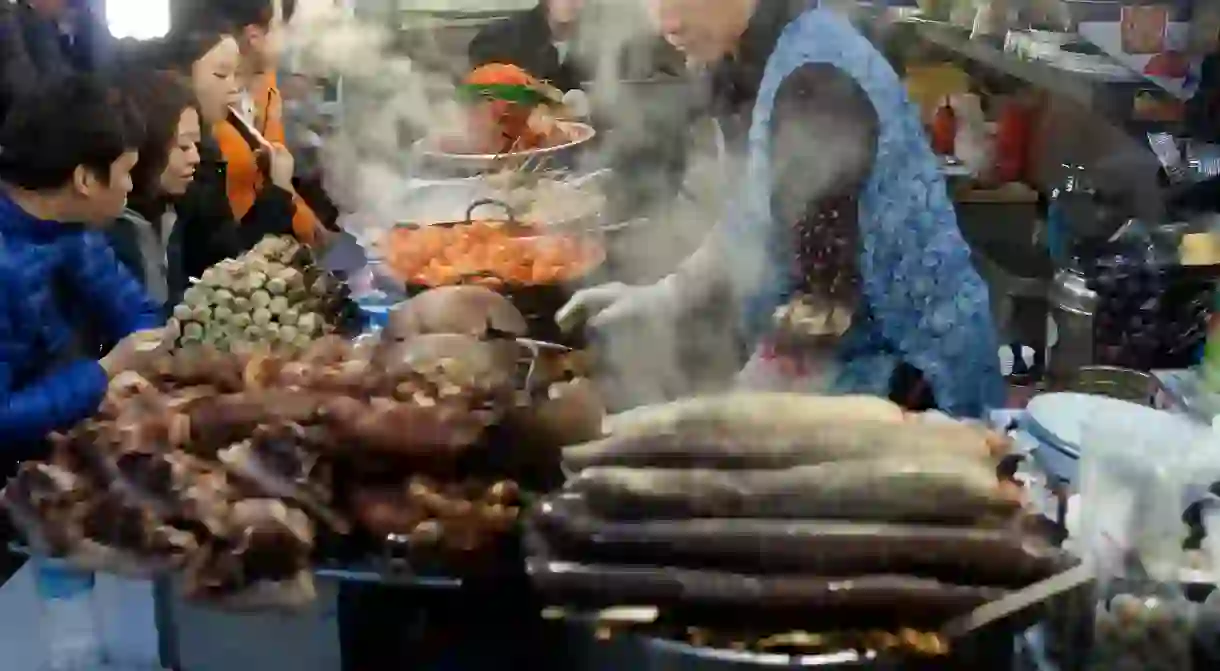The Best Food Markets in Daegu

Daegu, South Korea boasts a diverse range of delicious food. From spicy steamed ribs to chewy hand-cut noodles, there are all sorts of simple but tasty Daegu specialties to please just about every palate. Visit these traditional markets and food streets and get tasting.

Jjimgalbi Street
The Jjimgalbi Street in Dongin-dong goes back to the 1970s, when a local bar began serving jjimgalbi (steamed ribs) to laborers working at nearby construction sites. The dish quickly became popular and it wasn’t long before similar restaurants began cropping up in the area. Today, there are 12 jjimgalbi restaurants on this street serving up the spicy, mouthwatering dish.
The ribs are slowly cooked until incredibly tender and are steamed a final time with red pepper powder and garlic when ordered. When served, eat the meat first; the rice will be mixed in with the remaining sauce afterward. The spiciness of the rice can be balanced with baek-kimchi (white kimchi), which is served as a side.
Dongdeok-ro 36-gil, Jung-gu, Daegu, South Korea, +82-1330
Seomun Market
Market

The former is a savory noodle soup made with an anchovy and vegetable broth, and topped with sesame seeds for added flavor. The chewy noodles pair well with the kkakdugi (radish) kimchi and crunchy peppers. The latter, meanwhile, are made with a thin and chewy dough casing and tend to have slightly less filling than traditional Korean dumplings.
Servings at Seomun Market are generous and prices are affordable, so bring your appetite (and cash, as many of the dining establishments don’t accept cards).
Anjirang Market
Market

As evening goes on, the aromas of gopchang begins to permeate the kilometer-long street. Pork intestines are slightly boiled before being grilled on a briquette fire. After caramelizing, the dish is chewy and rich, a combination adored by Koreans all over the peninsula. Each restaurant has its own unique seasoning and dipping sauce to differentiate their dish from the rest.
Pyeonghwa Market
Market
Now home to over 30 restaurants, Pyeonghwa was first opened in the 1970s when a labor market was formed nearby. Laborers who failed to find work sought comfort in the market’s restaurants with a stiff drink and fried dakttongjip.
Today, the dish is served in three different ways: fried, seasoned with sweet sauce, or marinated in salty soy sauce. One dish is hearty enough to satisfy a few people. Opt for the modeum (mixed) combo, which includes a variety of dakttongjip and fried potatoes.
Nammun Market
Market

Visitors are served generous platters of warm slices of pork that can be folded in lettuce wraps, along with savory soybean paste, slices of raw garlic and spicy kimchi. Though this dish did not originate in Daegu, the local version is distinguished by the pork bone broth soup served with the pork.













